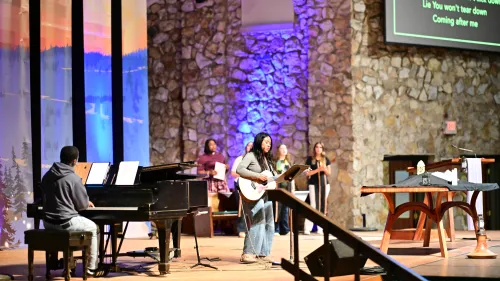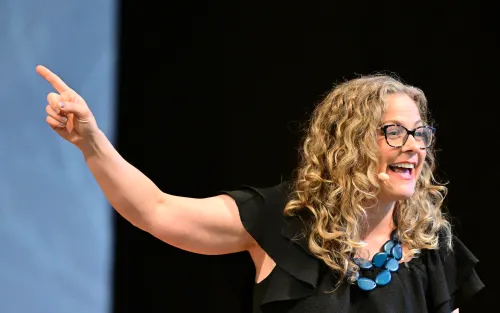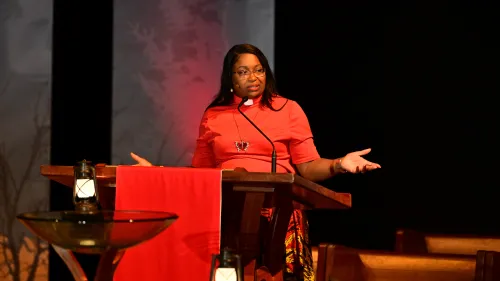Montreat Youth Conference lights the path for youth
Leaders make space for them to be who God made them to be
“Oh my, that’s a whole lot of folks,” said the Rev. CeCe Armstrong, Co-Moderator of the 226th General Assembly (2024), peering out from the stage of Anderson Auditorium at the Montreat Conference Center for the second week of the Montreat Youth Conference. She saw 800 youth and their leaders filling up the pews.

Armstrong, who served as the preacher for the first and second weeks of the conference, expressed surprise to the Rev. Casey Wait, the featured keynoter during those sessions, noting the crowd was exponentially larger than the week before. Last year, the Montreat Youth Conference welcomed more than 3,600 people over its six sessions in June and July.
“Do you want to pray before we pray?” Wait offered, guiding Armstrong to turn away from the 800 high schoolers and have a private — but microphoned — moment of “Help us, O Lord.” The performance of insecurity and uncertainty demonstrated an invitation for conference-goers to just be themselves and trust in God’s presence. The message of welcome and acceptance had already been delivered by Wait, recreation leaders the Rev. Neeley Rentz Lane and Alejandro Salas Hernandez, and music leaders the Rev. Kim Mendoza and Isaac Moshay at Sunday night’s opening event.

As part of their introductions, each leader shared a short biographical journey, saying, “The path that led me here started here and took me through … .”Wait, who hailed from Vermont and New York City, had never been to Montreat Youth Conference before finding herself on stage with the expectation of delivering five keynote speeches on this year’s theme, “Light My Path.” She gave voice to all the ways she and others may be feeling like outsiders while offering an orientation to the Montreat grounds and the slang used to name different spaces.
The intention toward hospitality and inclusion ran over into “the Huck” (Huckleberry Café), where Montreat staff and the conference pastor were available to treat guests to coffee or a theological conversation. On Monday, Susie Watson Burns, director of church relations at Montreat, sat near the window overlooking Lake Susan, calling local garages for affordable quotes to fix the broken-down van used by a church from Alpharetta, Georgia.
For over a decade, Burns has been finding opportunities to introduce the Montreat Youth Conference to new congregations of all sizes and means. “I help congregations live into their baptismal vows,” she said, describing her behind-the-scenes work: finding ways to include churches who may have only one youth and one leader, securing housing or scholarships for youth of new worshiping communities or immigrant churches, or walking through accommodations and support for youth on the spectrum of neurodiversity.
Burns sees Montreat as the place where lay leaders, church staff and conference organizers can come together to help youth find an authentic faith foundation, enough to carry them through the changes of young adulthood and life. “They can’t just inherit the faith of their parents. They have to find their own faith,” she said.
Tanner Pickett, vice president for communications at Montreat Conference Center, described two elements of the youth conference that stand out to him: small groups comprised of youth from all the various church groups and “back-home groups,” where youth process in the church groups with whom they came. “The juxtaposition of those two experiences is fascinating,” said Pickett. Reflecting on his own experience as a youth at the conference, he said, “For me, the most meaningful experiences when I was here as a youth were my back-home friends that were coming with all these really intense experiences, that we were able to talk about them in a much different way and at much deeper level.”
Wait wove the idea of accepting oneself and thriving in diversity throughout her keynotes. She identified how her own journey included the twists and turns of being “neurospicy.” After receiving a diagnosis of ADHD in high school, Wait presented her lifelong journey to accept the gifts and challenges of how she has been “fearfully and wonderfully made.”
“I relate to the keynote speaker because she is like me,” said a rising sophomore from Tucker, Georgia, who appreciated Wait’s candid references to how her neurodiversity shaped her thoughts and presentation style as well as the accommodations she named and normalized for youth who may struggle with sitting still in pews for an hour in a crowded and loud auditorium.
Along with her relatability, Wait’s creativity was appreciated by the youth. “I appreciate her use of media,” said one high school junior from Black Mountain, North Carolina. Several of Wait’s keynotes featured a creative video that she wrote, directed and produced. Using multiple wigs and pop culture references, Wait portrayed characters representing her various thoughts and insecurities. One voice resembled the Mother of Dragons from “Game of Thrones,” while another appeared to be the iconic hair of a controversial pop singer. That day’s small groups were atwitter with whether or not her pop culture references were heresy or hospitality, as some youth took offense and others thought it cool. At least one said, “I didn’t think I fit in here because I struggle with what I believe, but I was really glad to see Chappell Roan referred to in worship because she’s been so ostracized by church people.”

The next day, Wait revealed that at the age of 40, she became a visual artist. Her keynote about Nicodemus featured her sketching his image as she read the Scripture in a voice-over. In this same talk about the creative potential of uncertainty, Wait played a video clip of Sikh activist and writer Valarie Kaur, who spoke out against white nationalism and hate crimes against Sikhs and other Middle Eastern individuals. In the video from a Watchnight service of the Poor People’s Campaign on Jan. 17, 2017, calling for a moral revival in the midst of a polarized political climate, increases in the wealth gap and surges in hate acts toward marginalized communities, Kaur spoke about the power of revolutionary love and asked, “What if this darkness is not the darkness of the tomb but the darkness of the womb?”
Later that evening, as part of the “back home devotional guide,” youth were invited to discuss with their own church groups something challenging about their day. Many cited the video, which received mixed responses and revealed the breadth of political and theological perspectives within the small groups that met during the day.
“I was challenged today when this girl I really liked in my small group said things I didn’t agree with,” said a junior from Decatur, Georgia. “I found myself being offended by her political views, but I didn’t know how to say I felt differently without hurting the relationship. I imagined how Jesus made friends with all kinds of people and loved them. In the end, I just tried to be present and love her as Jesus would.”
A freshman from Atlanta said he was challenged by the avoidance of hard topics in his small group. “We just kept talking around things instead of just coming out and addressing what we didn’t agree on head-on.”
Another group from South Carolina struggled not with the political diversity but with the theological differences present when youth from many congregations and contexts come together. One chaperone worried that her small group bordered on universalism: “To not believe in hell is taking the easy way out.” The statement prompted that at-home group to consider if that was true or if undeserved grace in a broken and unjust world was a harder reality to accept. The associate pastor of the church later expressed his appreciation for the overall balancing act he saw between keynote speaker and preacher. He observed how Wait was able to address the real issues youth face every day and open these up for theological and ethical reflection while Armstrong resituated the themes within the tradition and found a theological middle where people could worship together.
Armstrong made space for the range of beliefs each evening as she tied the “Light My Path” theme to the liturgical calendar. While wearing a clergy collar in the color of a different season each night, Armstrong considered how God is present in darkness and light during Advent, Epiphany, Transfiguration, Resurrection and Pentecost. Hanging around Armstrong’s neck was a shiny red butterfly pendant that glittered every time it caught the light.

“Most folks who are preachers and religious types, they put a big old cross on so that everybody knows that they have Jesus Christ in their life,” said Armstrong, who explained that the cross, while representing a profound truth, was a symbol of torture, but the butterfly was a symbol of transformation and resurrection. “When you see the cross, it's your reminder of what Christ did for you. But the butterfly, for me, is the symbol that says what Christ did to me. There was a transformation.”
You may freely reuse and distribute this article in its entirety for non-commercial purposes in any medium. Please include author attribution, photography credits, and a link to the original article. This work is licensed under a Creative Commons Attribution-NonCommercial-NoDeratives 4.0 International License.




